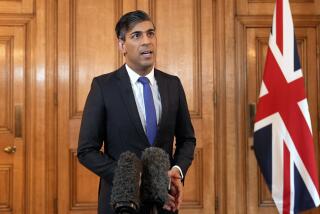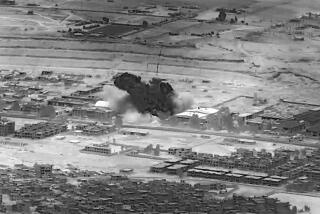Year’s U.S. troop death toll the highest of the Iraq war
- Share via
BAGHDAD — This year has become the deadliest for American troops in the Iraq war since the 2003 invasion, with the U.S. military’s announcement Tuesday of the deaths of five soldiers and a sailor in roadside bombings.
The attacks brought the total number of U.S. troops killed this year to at least 854, eclipsing the previous high of 849 set in 2004, according to data compiled by icasualties.org, an independent website that tracks Iraq war casualties. With more than seven weeks left to go in the year, the toll was on pace to far outstrip any previous year.
At least 3,857, American troops have died since the conflict began in March 2003, according to the website.
The new benchmark came even as the U.S. and Iraqi governments have been reporting progress in securing the country and moving toward fresh steps to rebuild it. After a heavy toll among troops earlier this year, U.S. officials have been encouraged by two straight months of declines that put troop deaths at their lowest monthly level since March 2006. Deaths among civilians reportedly are also down, raising hope among officials that Iraq violence may have turned a corner.
The 38 U.S. military personnel killed in October represented a decline of more than 40% from the 65 deaths recorded the previous month.
In addition to a military buildup that increased the U.S. force level by nearly 30,000 troops, U.S. officials pursued a new strategy that put troops at greater exposure than in the months before. The military moved large numbers of troops from bases and stationed them in outposts in the communities they were assigned to safeguard, leading to an increase in deaths earlier in the year.
“We knew going into this that with the new strategy there was a potential for more casualties,” said Army Col. Steven Boylan, a spokesman for Army Gen. David H. Petraeus, the top military commander in Iraq. “When the strategy became to protect the civilian population, that automatically increased the risk to our forces, because you have to be out in the population to do that.”
The particularly bloody months of April, May and June each saw more than 100 troop deaths. May’s toll of 126 was the third-highest since the American-led invasion.
The U.S. military released few details Tuesday about the attacks that cost the lives of the six American troops the day before.
One was killed while conducting combat operations in Anbar province. Four others were killed when a roadside bomb exploded near their vehicle outside the city of Kirkuk in Tamim province. The sailor was killed by an explosion in Salahuddin province.
Also Tuesday, the U.S. military announced the noncombat deaths of an American soldier the same day in Kuwait and of another GI the day before in Taji, north of Baghdad.
At a briefing to announce advances in finding and destroying weapons caches, a spokesman for the military said the U.S. intended to release nine Iranians in custody.
The spokesman, Navy Rear Adm. Gregory Smith, said the Iranians had been “assessed to have no continuing value” and did not pose “further” threat to Iraq’s security. He did not say whether there were others who would remain in U.S. custody.
One cache discovered by Iraqi and U.S. troops included more than 1,000 mortar rounds, hundreds of which had been modified to use in roadside bombs; 3,000 detonators; and 59 grenade launchers.
Military officials said a joint Iraqi-U.S. mission reported finding a mass grave containing 22 bodies Saturday near Tharthar Lake northwest of Baghdad. The area is used as a base by insurgent, including the Sunni group Al Qaeda in Iraq. Two facilities for making car bombs were found and destroyed during the operation, and 30 people were detained.
Six policemen were shot to death as they left their vehicles Tuesday afternoon to enter the police station in the town of Tall Uwaynat, northwest of Mosul, police said. The gunmen were not apprehended.
Police in Baghdad reported finding on the streets the bodies of four men who had been shot to death.
christian.berthelsen@latimes.com
--
Times staff writers Saif Hameed, Wail Alhafith and Usama Redha and a special correspondent in northern Iraq contributed to this report.
More to Read
Sign up for Essential California
The most important California stories and recommendations in your inbox every morning.
You may occasionally receive promotional content from the Los Angeles Times.













